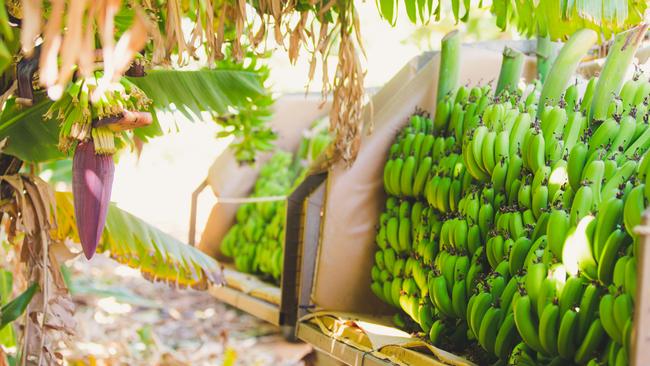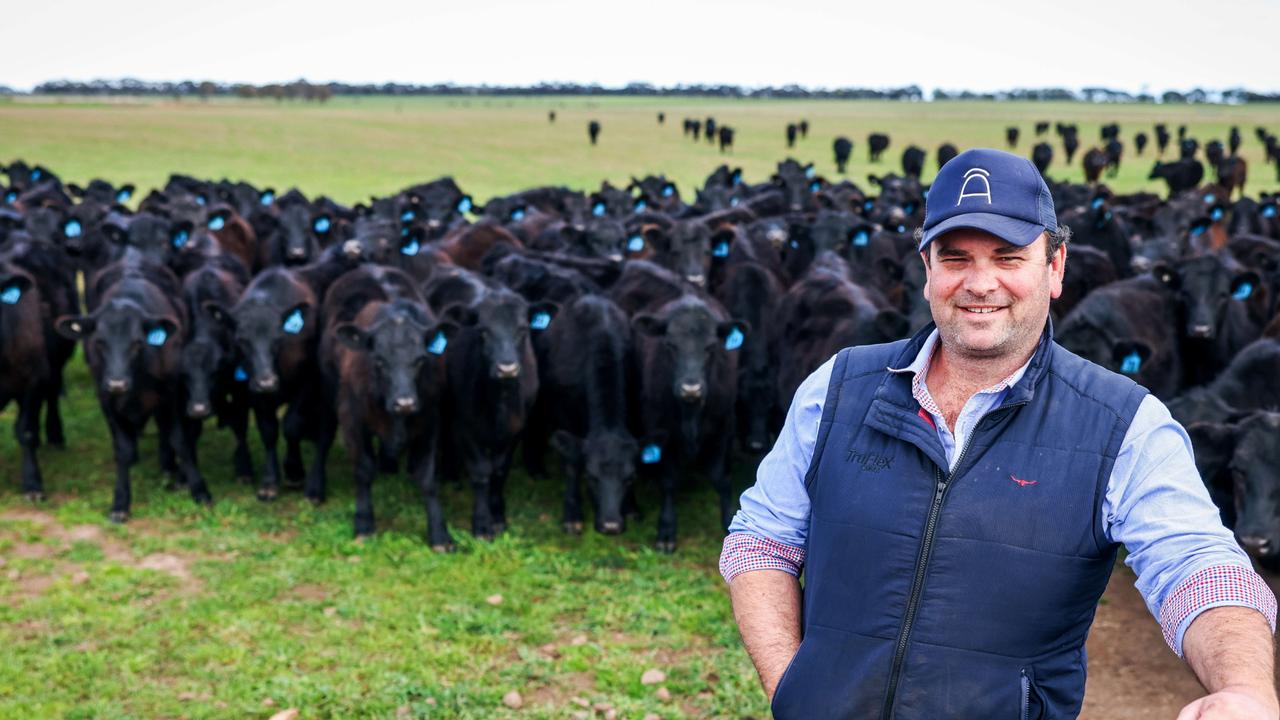The sweet life: How this co-op has challenged Queensland bananas
Traditionally grown in the tropics, bananas are often associated with Far North Queensland, but this small co-operative out of WA is challenging industry perceptions.

There might not appear to be much common ground between a bottle of wine and a bunch of bananas.
But the bright bunches of bananas decorating school lunch boxes and family fruit bowls across the country have taken a number of lessons from viticulture: namely, the importance of place, and the affect of a long and slow ripening season in a temperate climate.
Based at Carnarvon in Western Australia, a co-operative of banana growers have united under the banner Sweeter Banana, taking advantage of the unique climatic conditions and local appetite in the west for a smaller, creamier banana.
By pooling resources, focusing on monetising seconds and waste products, and marketing the unique flavour profile of their bananas, the 100 grower members are able to mobilise their product and work separately – not against – the more dominant northern Queensland banana.

A GOOD BUNCH
The co-op was formed more than 20 years ago in 2002 by a group of Western Australian growers, first as an association and then a co-operative.
Sweeter Banana co-operative business manager and former grower Doriana Mangili said the co-op is owned by grower members, with no external share holders and a board of only growers.
She said the small scale co-op means producers “have to be really innovative”.
“Carnarvon is 900km north of Perth. It’s a subtropical area, and we don’t get that warm tropical weather bananas need. We get cold winters, and really hot summers. Everything’s stacked against us, the climate is hard and we get those cosmetic things that are traditionally unattractive to customers.”
Despite the challenges, it is specifically the smaller, sweeter bananas locals are chasing, and has become the product’s strength.
Sweeter Banana products are now found at major supermarkets in Western Australia, including Woolworths, Coles, and Costco, along with a number of other smaller-scale grocers.
The small bananas are perfect for lunch boxes, their smaller size and growing conditions lend a sweeter, unique flavour profile, and consumers enjoy being able to buy a locally-grown product.
“They’re creamy and sweet, because they take twice as long to grow,” Ms Mangili said.
SWEET ESCAPE
Since 2006, Sweeter Bananas co-operative chairman Chris Collins has run Mundilya Farm at Carnarvon, a 54ha operation producing pumpkins, bananas, and watermelons.
“The main driver was that horticulture looked like a pretty good industry at that time. The rewards were there, if you did the job correctly,” Mr Collins said.
Since then, he has been focused on growing quality, locally-produced bananas.
He sells all of his fruit through the co-op, producing about 650 tonnes of fruit annually.
“We grow that fruit on farm, harvesting and transporting to the packing shed, and from there the co-op takes care of everything else,” Mr Collins said.
“It’s graded, washed, packed, marked, and handled, with proceeds ultimately paying the grower.
“It takes that whole side of the business away and we can focus on growing the actual bananas, we don’t have to focus on packing and marketing it.”

Bananas are a long-term crop, Mr Collins said, with a tree kept productive for between five to eight years.
“After my bananas are done with production, I’ll use that ground to grow watermelons as there’s plenty of nutrients left over from the bananas, and it works well with our mix,” Mr Collin said.
Bananas are harvested weekly, even in winter.
“Carnarvon gets cold, we can have nights below 10C, and bananas don’t really like that, so production slows in winter dramatically,” Mr Collins said.
“But we’ll harvest every week of the year, with more volume in the summer. We work for a winter production.”
New trees are planted between August and October each year, with the aim for those trees to come online for a winter harvest.
“Production is reached in 18 months,” Mr Collins.
The variety is Cavendish, which is the same as what’s mostly grown across the country.
“What happens is in a subtropical environment, our cycle time from bunch to bunch is significantly longer than tropical bananas. The bananas convert more starch to sugar. We’ve had taste tests and trials done, mostly by Curtin University.”
The pay-off of this longer growing time, Mr Collins said, is while the growing slows during winter in comparison to more northern farms in Queensland, there are benefits to the Western Australian environment.
“Our yields are up there with some of the top yields in the world, per ha,” Mr Collins said.
“Because of our remote location, and because we’re not tropical, we have zero bunch pests. We don’t have to spray, we don’t have to bag our bunches, and use no insecticides or pesticides, and that’s a massive upside for us.”
On his farm, Mr Collins employs one full-time employee to every 4ha of bananas or about three people full time, plus himself.
Other major imports are water.
“We live in an arid region and it never rains so on of our larger costs is water, up to 24 megalitre per ha per year, depending on the year,” Mr Collins said.
“Water and wages are the biggest cost. Packing and transport is also a huge cost.”

THE SWEET LIFE
While “the devil’s still about sometimes”, Mr Collins said there were myriad opportunities for growers in the west focusing on bananas production.
“The fact it doesn’t rain as much means we don’t get fungus, it’s a massive thing not having to use chemicals, it’s a really big plus for growing in that region,” Mr Collins said.
“While it is a tough place, economically it does stack up. About 95 per cent of bananas are grown in Far North Queensland, and that’s a long way from Western Australia. We’re growing a local product.”
The result of investing time and resources into the co-op is Sweeter Banana represents about 60 per cent of the Western Australian industry, sending about 15,000 cartons of bananas per week, against the on average 50,000 cartons sent from Queensland into Western Australia weekly.
And being a member of a co-operative has its benefits, according to both Mr Collins and Ms Mangili, such as sharing of capital resources and spreading the load of marketing and selling the product into stores.
“From a marketing point of view, the markets are where you need to be, and the big chain stores are not going to deal with 20 separate growers. But one co-op representing all 20 then they will deal with us then,” Mr Collins said.
“The biggest problem can be getting the group of people together to get along, and who have the same common goal. For whatever reason, whether it’s good management or good people, it really works for Sweeter Bananas.”
The future has more opportunities for Sweeter Bananas to expand operations, and to look at further monetising seconds products which would otherwise go to waste.
“With growing fresh produce there can be at times of the year a lot of waste. In bananas in the bad old days we’d have 30 to 40 per cent waste. We’ve just leased another property in town for the co-op and are embarking on a zero-waste journey,” Mr Collins said.

In the past, waste bananas would go on a truck and be tipped onto a paddock as fertiliser. Those are now packed up, they’re sent to a separate facility, ripened, and either peeled or frozen.
“We’re also embarking on a project to freeze dry bananas as a health snack. The facility is up and running, but it’s been a bit of a journey there with the marketing.
“We’re quietly excited.”
“Food waste is a big issue. If we can sell that, all of a sudden it makes the bottom line look better. And you don’t have to get a lot for it either.
“If it’s going into the bin, it still costs you to handle that product.”





